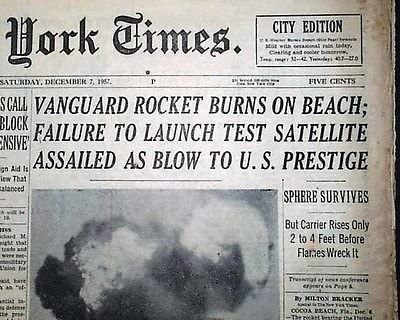Kaputnik: The Vanguard TV-3 Failure and the Vanguard Program
- Aeryn Avilla
- Dec 6, 2021
- 7 min read
Updated: Feb 17, 2025
Vanguard Test Vehicle 3 (TV-3) was the United States' first attempt at putting a satellite into Earth orbit. Meant to succeed the Soviet Union's Sputnik 1 and 2, it was a spectacular failure and a humiliating loss for the US. Though best remembered for its string of failures, Vanguard was the first American rocket designed specifically for launching satellites and was the first vehicle to launch from Cape Canaveral that was not tied to a weapons system [1]. This post focuses on the entire Vanguard program with emphasis on the TV-3 incident. It is important to note here that Vanguard TV-3 was the name of the major disaster while Vanguard 1A was the name of its specific satellite.


Contrary to popular belief, Vanguard's satellites were not an American response to the Soviet Sputnik...at least not originally. Vanguard was the product of the International Geophysical Year (IGY) Vanguard Satellite Program. The IGY, which lasted from the summer of 1957 until the end of 1958, was a global effort to collect geophysical data from around the world. The Vanguard Satellite Program was designed to achieve the goal of launching one or more Earth orbiting satellites before the IGY was over. In particular, the satellite was meant to test the launch capabilities of a three-stage launch vehicle, study the effects of the space environment on a man-made object, and obtain geodetic measurements of the Earth [2]. The decision on which rocket to use was made by the Stewart Committee in 1955. The small group's formal name was the Advisory Group on Special Capabilities and was called the Stewart Committee in honor of its chairman, Homer J. Stewart. It was formed by Donald Quarles, the Assistant Secretary of Defense for Research and Development. The committee included eight members— two each from the Army, Navy, and Air Force with another two appointed by Quarles. Each of the three military branches had its own proposal:
Army (in conjunction with Navy): Project Orbiter - use a multi-stage version of an Army Redstone rocket as a booster
Navy (Naval Research Laboratory): Project Vanguard - use a multi-stage version of the Viking research rocket as a booster
Air Force: use the not-yet-flown Atlas ICBM as a booster
The Navy's Vanguard was approved by President Dwight D. Eisenhower on September 9, 1955. The key advantages Vanguard had over the other two proposals are as follows:
Civilian management: The project was funded by the National Science Foundation and development of both the booster and satellite was managed by civilians. President Eisenhower was keen on distancing the military from the IGY.
Proven vehicle: Viking carried an 853-pound scientific payload to an altitude of 158 miles (254.28 km) on May 24, 1954. Numerous artificial objects had been hurled into space since 1944 but none achieved orbit.
Ballistic missile development: Vanguard would not draw resources away from the Army's and Air Force's ballistic missile research.

Vanguard 1A was an aluminum sphere 6.4 inches (16.3 cm) in diameter weighing 3.3 pounds (1.5 kg). Inside the sphere was a heat shield-lined cylinder that held the instrument payload consisting of a set of mercury batteries, a telemetry transmitter, and a Minitrack beacon transmitter powered by solar cells mounted on the outside of the satellite [3]. These six solar cells had a side length of about 5 cm and were manufactured by Bell Laboratories, who later played a role in the development of Telstar [4]. Additionally, six 30 cm-long spring-actutated aluminum alloy aerials extended out from the sphere, an iconic characteristic of Sputnik. The satellite also included transmitters for tracking data and two thermal resistors to measure the interior temperature [5]. This was to determine the effectiveness of the thermal protection. During launch, a cylindrical separation device kept Vanguard attached to the third stage. In order to deploy, a strap would be released and three springs would separate the satellite from the cylinder at a relative velocity of about 1 foot (0.3 m) per second.

The first stage of the Vanguard launch vehicle was a modified Viking rocket, consisting of a General Electric X-405 liquid engine propelled by kerosene and liquid oxygen and capable of producing 28,000 lbs (12,700 kg) of thrust. The second stage engine was the Aerojet-General AJ-10 liquid fuel engine producing 7,500 lbs (3,402 kg) of thrust. This stage also contained the complete guidance, navigation, and control system. The third stage, known as Altair, was a solid propellant developed by Grand Central Rocket Company, which later became the Lockheed Propulsion Company and is now part of Lockheed-Martin. It produced 3,100 lbs (1,406 kg) of thrust. The total height of the vehicle including the satellite fairing was 72 ft (21.9 m) with a diameter of 3.75 ft (1.14 m). It had a payload capacity of 25 lbs (11.3 kg) to an altitude of 345 miles (555 km). This was the same launch vehicle configuration, with few modifications, that was used by all succeeding Vanguard flights.
The first test of Vanguard occurred on December 8, 1956. Setting the tone for the rest of the program, it was a failure. The second test was not until May 1, 1957 with the third taking place on October 23, less than three weeks after Sputnik became the first artificial object to orbit the Earth. The first two launches, TV-0 and TV-1, only tested the Viking first stage and second stage motor. After Sputnik 2 put the first living creature into orbit ten days later on November 3, the US made the bold decision to attempt its own satellite launch onboard the next available Vanguard rocket. This meant the launch of TV-3 happened "prior to the conclusion of the test series originally indented to validate the Vanguard rocket" (Lethbridge). Success was doubtful since it was the first Vanguard rocket to fly with powered upper stages and with the intent of putting an object into orbit.
Vanguard TV-3 carrying the Vanguard 1A satellite launched from Cape Canaveral's Launch Complex-18 on December 6, 1957. At T minus 0, the booster ignited and began to rise. After about 2 seconds and rising approximately 4 feet (1.2 m), the rocket lost thrust and began to settle back down onto the pad. At that moment, the fuel tanks ruptured and exploded, destroying the rocket and severely damaging the launch pad. The satellite was hurled away from its launch vehicle and landed on the ground a short distance from the structure. Even at impact, its transmitters were still sending out a beacon signal.
Video of the Vanguard TV-3 explosion (YouTube)
The exact cause of the disaster was never determined. It was likely due to a fuel leak between the fuel tank and engine, possibly as a result of a faulty connection in a fuel line or low fuel pump inlet pressure. This would have allowed some of the burning fuel back into the thrust chamber. The failure of Vanguard TV-3 was a humiliating blow to the United States's reputation, having been reported in international media. American news agencies published newspapers detailing the catastrophe, typically with headlines including plays on the name "Sputnik" such as "Kaputnik", "Flopnik", "Dudnik", and "Stayputnik". The Martin Company, the prime contractor for Project Vanguard, was temporarily suspended by the New York Stock Exchange.
The New York Times's and Daily Herald's responses to Vanguard TV-3 (Public Domain)
The second attempt of putting a satellite in orbit using a Vanguard rocket occurred on February 5, 1958 and failed. The next launch took place on March 17 and successfully placed Vanguard 1 in orbit, where it will remain as the oldest man-made object in space for the next two hundred years or so [6]. The satellite revealed that Earth is not perfectly spherical but rather pear-shaped. It also validated the use of solar cells for powering satellites and spacecraft [7]. It was essentially identical to Vanguard 1A. The following four launch attempts were failures though Vanguard 2 reached space on February 17, 1959. After two more failures, the last launch of the Vanguard rocket successfully took place on September 18, 1959 and sent the Vanguard 3 satellite around the world. Unlike Vanguard's 1A and 1, Vanguard's 2 and 3 were instrumentation satellites weighing over 22 pounds (12.7 kg).
Despite only three of its fourteen flights being successful, the Navy Vanguard rocket had a lasting legacy and did in fact meet its original IGY objectives. The vehicle's upper-stages became the basis for the upper-stages of the later Atlas-Able, Thor-Able, and Scout rockets, as well as the Atlas-Antares second stage used in NASA's Project FIRE to test proposed Apollo re-entry vehicle designs.
There were two unexpected positives that resulted from the failure of Vanguard TV-3 as well. First, the problem allowed the Army Ballistic Missile Agency to launch the first American satellite, Explorer 1, into space on January 31, 1958 atop a modified four-stage version of the Redstone missile known as Juno. Second, Vanguard 1A, although damaged beyond repair or reuse, was miraculously still mostly intact and is now on display at the National Air and Space Museum in Washington, DC for all to learn about. Project Vanguard Manager John P. Hagen rescued the satellite after the booster exploded and gave the artifact to the Smithsonian in 1971. It was on display when the National Air and Space Museum opened in 1976.
Vanguard 1A satellite (Smithsonian)
The Vanguard program was a product of the International Geophysical Year and managed by the US Naval Research Laboratory. Its objectives of testing the launch capabilities of a three-stage launch vehicle, gaining information about the shape and size of Earth, and investigating the effects of the space environment on a man-made object were met, despite the program's numerous failures. Although best remembered for the Vanguard TV-3 incident, this early project paved the way for launch vehicles and satellites of future decades.
Author's note: As always, thanks for reading and be sure to like, comment, and share this post!
[1] At the time, all other launches were of either cruise missiles, ICBMs, or IRBMs (inter-range ballistic missiles).
[2] Geodetic relates to geodesy, the branch of mathematics that deals with the shape and area of the Earth.
[3] The Minitrack was the first US satellite tracking network and tracked the flights of Sputnik, Vanguard, Explorer, and other early American and Soviet satellites. "Minitrack" is a shortening of the name "Minimum Trackable Satellite".
[4] Telstar was the first active communications satellite launched in 1962.
[5] These instruments are referred to in technical documents as "thermistors", a combination of the words "thermal" and "resistor".
[6] Original estimates had Vanguard 1 remaining in orbit for another 2,000 years but atmospheric drag and solar radiation have degraded its orbit more than anticipated.
[7] The conventional batteries used to power one of its on-board transmitters lasted only twenty days. The solar cells operated for about seven years.
Bibliography
Lethbridge, Cliff. “Vanguard Fact Sheet.” Spaceline, https://www.spaceline.org/cape-canaveral-rocket-missile-program/vanguard-fact-sheet/.
“Satellite, Vanguard TV 3.” Smithsonian National Air and Space Museum, https://airandspace.si.edu/collection-objects/satellite-vanguard-tv-3/nasm_A19761857000.
Williams, David R. “Vanguard TV-3.” NASA Space Science Data Coordinated Archive, https://nssdc.gsfc.nasa.gov/nmc/spacecraft/display.action?id=VAGT3.










